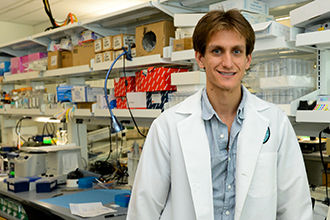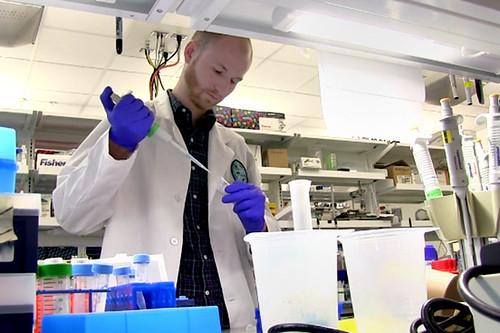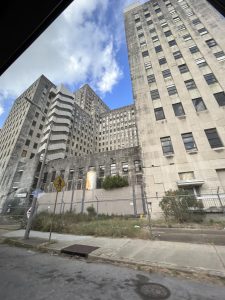Bioinnovation students regenerate esophagus, nipple tissue

Derek Dashti recently placed in the top 15 in the Rice Business Plan Competition for his company D&P Bioinnovations
April 20, 2016
Business, biotechnology and human biology successfully meshed together in Tulane Ph.D candidates’ pursuits in bioinnovation, earning top places in business competitions.
Bioinnovation Ph.D candidates Derek Dashti and Nick Pashos recently competed in the Rice Business Plan Competition, with Dashti winning $1,250 in a fifth place finish and Pashos winning $1,000 in a challenge round. Pathos also won the $25,000 Women’s Health and Wellness Prize and first place in the experienced researcher category in Tulane’s own Novel Tech Challenge last week.
During their studies, Dashti and Pashos each launched companies dedicated to developing biotechnological solutions to major health problems. Pashos’ company, BioAesthetics, is dedicated to reconstructing the nipple-areolar complex, or NAC, for patients who have undergone mastectomies. Dashti’s company, D&P Bioinnovations, aims to regenerate damaged esophagi, the organ that provides food to the stomach. Though Dashti leads D&P Bioinnovations as its founder, inventor and chief science officer, Pashos serves as the company’s president and bioengineer.
Ochsner Health System and Tulane surgeons approached Dashti early in his doctoral studies, highlighting the dire need for a better approach to esophagus reconstruction.
“Patients have no other alternative than to undergo this highly invasive procedure,” Dashti said, referring to gastric pull-up, a complex surgery in which a portion of the stomach is pulled up to reconnect the esophagus to the digestive system. The surgery is characterized by high death rates and postoperative complications, he said.
Esophageal cancer, which causes damage to the esophagus, is relatively rare in the U.S., affecting around 17,000 persons yearly. Its global impact is greater: each year, 81 percent of the 450,000 cases worldwide are diagnosed in less-developed nations with most cases occurring in Asia and Africa. Dashti’s implantable device can also address esophageal birth defects and toxin ingestion in children.
Pashos credits the 2011 documentary “Becoming Chaz” for sparking his interest in NAC reconstruction. The film details Chaz Bono’s — only child of Sonny and Cher — gender transitioning from woman to man, specifically the medical and surgical procedures Bono undergoes. Pashos’s lightbulb moment came during a scene in which surgeons discussed Chaz’s chest reconstruction.
“They were joking about the nipples not being there or something like that,” Pashos said.
Current standards for NAC reconstruction involve a skin-grafted nipple and tattooed areola, he explained.
Photo courtesy of Tulane Public Relations
Nick Pashos’ company, BioAesthetics, works on nipple-areolar complex reconstruction
While the majority of patients receiving mastectomies are female breast cancer survivors, BioAesthetics can address the needs of male breast cancer survivors, surgical reconstructions of the chest and other instances in which the NAC might be compromised.
Dashti and Pashos may be interested in fundamentally different physiological problems, but viewed simply, their approach to solving these problems are similar. Both implement “scaffolds” onto which the patient’s own cells are trained to regrow.
Made of collagen, a structural protein found in the body’s skin, bones and connective tissues, Pashos’ scaffold is biologically derived.
“When you build a house … you build a scaffolding first and then add on top of it,” Pashos said. The patient’s skin cells are grafted to the collagen scaffold, and since the scaffold provides structure and support, the cells can grow and ultimately regenerate the NAC. “[The cells] are like the siding and the windows.”
Ultimately, Pashos said the result is a more complete reconstruction.
“It helps in self-esteem, body image and decreasing the feelings of distress a woman may feel after having a mastectomy,” Pashos said.
Dashti’s device, on the other hand, is made of biodegradable, synthetic polymers. Once the device is implanted in the patient’s throat, it coaxes esophageal cells into regrowing. Ultimately, the material biodegrades, leaving a reconstructed, functioning organ in its place. Dashti sees potential for his technology to regenerate damaged connective, muscle and nervous tissues as well.
Both Dashti and Pashos plan to graduate within the year, and will be among the first class to complete the interdisciplinary doctorate in bioinnovation. After completing their studies, the two scientist-entrepreneurs will continue to build their businesses in the hopes of bringing their product to market. Plenty of obstacles are ahead: patents, trials, funding and Food and Drug Administration approval. But Dashti and Pashos have been trained to navigate these hurdles.
“My success has been because of Tulane and the [New Orleans] BioInnovation Center and this unique program I’m in that allows Ph.D students in the biomedical field to set themselves up for a career that’s not necessarily academia, but more industry-like,” Dashti said.










Leave a Comment